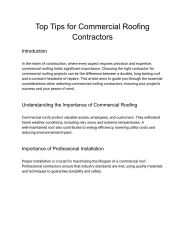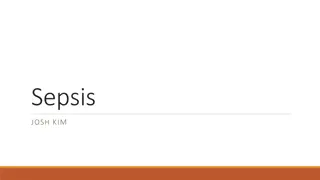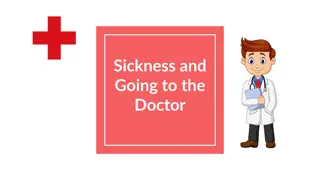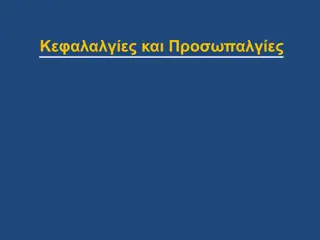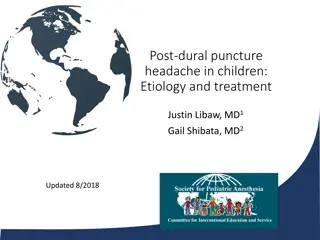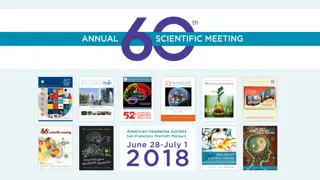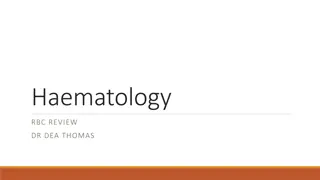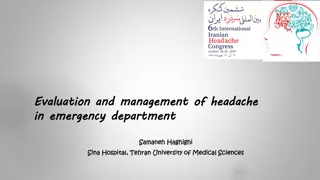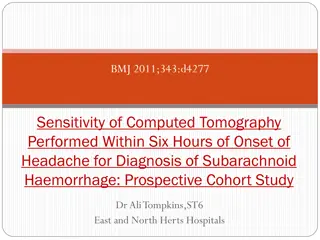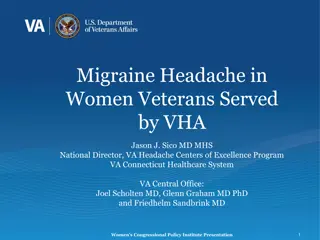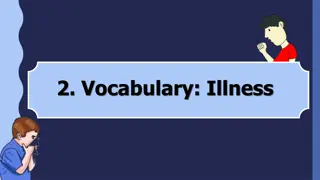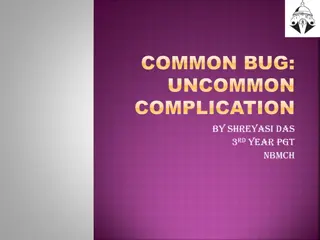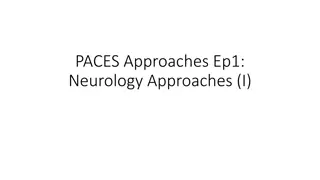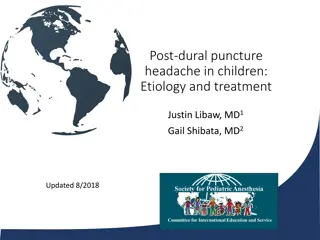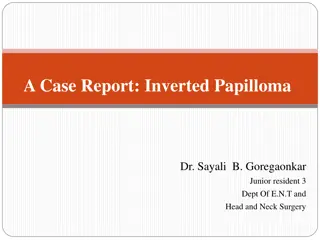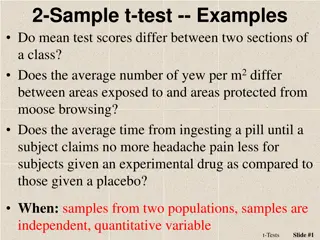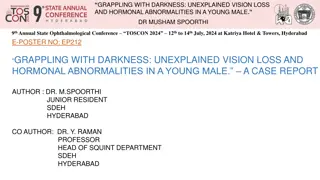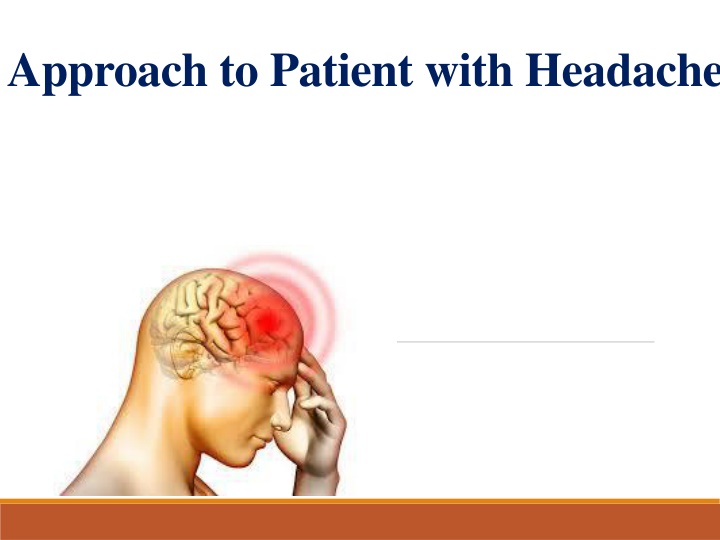
Comprehensive Approach to Understanding and Managing Headaches
Explore the classification of headaches, common causes, red flag symptoms, and referral criteria. Learn to conduct a focused history and physical examination to identify underlying factors and differentiate between primary and secondary causes. Discover preventive strategies and recognize rare but serious treatable causes.
Download Presentation

Please find below an Image/Link to download the presentation.
The content on the website is provided AS IS for your information and personal use only. It may not be sold, licensed, or shared on other websites without obtaining consent from the author. If you encounter any issues during the download, it is possible that the publisher has removed the file from their server.
You are allowed to download the files provided on this website for personal or commercial use, subject to the condition that they are used lawfully. All files are the property of their respective owners.
The content on the website is provided AS IS for your information and personal use only. It may not be sold, licensed, or shared on other websites without obtaining consent from the author.
E N D
Presentation Transcript
Case scenario A 27-year-old single female , she is a primary school teacher. She presents to the Surgery C/O headache for the past few months. She describes the headache as the band like around her head. The headache increase in intensity towards the evening times. It relieved by taking Paracetamol for some times but it recurs .She mentioned that the headache is progressive throughout the day to become more intense , by the end of the day .She denies any other symptoms like nausea, vomiting, diplopia or flash of lights. Her past medical history and the physical examinations are unremarkable .
OBJECTIVES Classify the headaches based on primary and secondary causes . Identify Common causes of primary headache. Conduct a focused history for a patient presented with headache to identify the etiological factors. Identify important related physical examination to exclude serious causes Assess and treat the patient presenting with headache, Identify red flag symptoms to exclude serious causes.
Identify some rare but serious and treatable causes of headache. Recognize the limitations of images for the diagnosis of headache, Recognize the preventive and prophylactic strategies available for some types of chronic headache. Identify the referral criteria for headache. Act as a gate keeper not to waste the resources
Definition Headache is pain localised to any part of the head, behind the eyes or ears, or in the upper neck. Headaches represent 2% of all emergency department visits. About 90% of men and 95% of women have at least one headache per year.
Classification Of Headaches Primary: headache disorders, here the etiology is unknown Secondary: headache disorders, where the headache is attributed to a specific underlying cause in head or neck Chronic headache: Occurs on more than 15 days per month for more than three months.
Cont. classifications Secondary - infectious (dental, sinusitis, meningitis ) - Traumatic - Rebound - Intra-cranial hypertension ( idiopathic, brain tumor) Temporal Arteritis Primary -Tension-type headache - Migraine headache - Cluster headache
Tension-type headache Most common type of primary headache More in women than men . Mild to moderate in intensity Bilateral Pressing and tightening (non-pulsating) headache Not aggravated by movement such as walking or climbing stairs.
Migraine headache Unilateral Pounding Moderate to severe pain Worse with exercise Associated with nausea, vomiting, photophobia, or phonophobia
Cont. Migraine with aura (in 15-33% of patients with migraine). Migraine without aura Aura refers to feelings and some neurological symptoms person notices it shortly before the headache begins, and it differs from one person to another. It include: Nausea, Fatigue, Difficulty concentrating, Stiff neck, and repetitive yawning. The most common aura is a visual one that can involve sensitivity to light or blurred vision .
Cluster headache Very Severe Frequent Associated with parasympathetic autonomic features: injected sclera Lacrimation rhinorrhea facial sweating eyelid swelling
Causes of primary headache Contraction of the muscles that cover the skull Physical or emotional stress Dehydration
History Taking Age at onset Presence or absence of aura and prodrom? Frequency, intensity, and duration of attack Number of headache days per month Family history of migraine
Associated Symptoms Condition Fever Systemic infection: meningitis, encephalitis, brain abscess, otitis media. Mass lesion, brain abscess, migraine, carbon monoxide poisoning. Mass lesion, stroke, meningitis, encephalitis, metabolic, toxic. Vomiting Seizure Dizziness Ischaemic or haemorrhagic infarct (posterior fossa), migraine.
Neck pain Meningitis, subarachnoid haemorrhage, tension headache, musculoskeletal pain (cervical paraspinal muscle pain). Facial pain Temporal area: giant cell arteritis, trigeminal neuralgia Eye area: glaucoma Ear area: otitis media Sinusitis. Migraine, acute angle- closure glaucoma. Visual disturbance Neck pain Meningitis, subarachnoid haemorrhage, tension headache, musculoskeletal pain (cervical paraspinal muscle pain).
Urgent considerations - Meningitis Presents with fever, headache, stiff neck. Patients may develop meningococcal sepsis, presenting with hypotension, altered mental state, and purpuric or petechial rash. Patients should have a lumbar puncture (LP) within 1 hour of arrival at hospital, provided it is safe to do so, and commence antibiotic treatment immediately afterwards. - If high suspicion, antibiotics should be administered empirically before LP. If LP is delayed for CT, blood cultures should be obtained and broad-spectrum antibiotics given before CT.
Subarachnoid haemorrhage (SAH) - About 1% of all patients presenting to the emergency department with headaches have SAH. - It may present with a 'thunderclap' headache (sudden onset of severe headache, seen in 12% of SAH). Sudden onset, worst headache of life Immediate CT
Hypertensive encephalopathy Elevated BP, mean arterial pressure >150 to 200 mmHg Immediate CT BP should be quickly lowered by 20% to 25% (labetalol, nicardipine).
Giant cell arteritis Patient >50 years, with their first severe headache Erythrocyte sedimentation rate is checked Immediate treatment with corticosteroids is required to prevent blindness if diagnosis is suspected.
Acute angle-closure glaucoma Headache in older person (>50 years) Decreased visual acuity, nausea/vomiting, eye pain, mid-dilated fixed pupil Intra-ocular pressure should be reduced (pilocarpine, timolol, acetazolamide) Ophthalmology consultation.
Raised intracranial pressure Untreated may lead to permanent sight loss, permanent neurological deficit, and death. Constant, severe headache. May be aggravated by coughing, straining, or bending. - One third of patients report a headache that is worse on waking. Patients also experience visual symptoms including blurred or double vision, and transient losses of vision. Examine fundi for papilloedema. Urgent neuroimaging looking for mass lesion, followed by lumbar puncture if safe.
CONT. Effect of pain on activity Relationship with food Response to any previous treatment Any recent change in vision Association with recent trauma State of general health
Physical Examination The majority of patients with a headache will have a normal physical examination. There are a few clues and important aspects of the physical examination that require close attention.
Vital signs Elevated BP: consider hypertensive emergency, hypertensive urgency Temperature: consider infectious source. Head, eyes, ears, nose, and throat (HEENT) Listening for bruit at neck, eyes, and head: atrioventricular malformation Palpation of head and neck for tenderness: paraspinal muscle tenderness/tension headache Tenderness over frontal and/or maxillary sinuses: consider sinusitis
Tenderness over temporomandibular joint (TMJ): TMJ dysfunction Neck stiffness/meningismus: meningitis Palpation of temporal artery for tenderness: giant cell arteritis Fundoscopy and Snellen chart: papilloedema (causes of raised intracranial pressure) Dental examination: caries/wisdom tooth impaction Ear examination: otitis media.
Focused physical examination Extracranial structure evaluation such as carotid arteries, sinuses, scalp arteries, cervical paraspinal muscles Examination of the neck in flexion versus lateral rotation for meningeal irritation. Even a subtle limitation of neck flexion may be considered an abnormality
Neurological examination Assessment of orientation, consciousness (Glasgow coma scale), presence of confusion and memory impairment Ophthalmology examination to include pupillary symmetry and reactivity, optic fundi, visual fields, and ocular motility Cranial nerve examination to include corneal reflexes, facial sensation, and facial symmetry Symmetrical muscle tone, strength (may be as subtle as arm or leg drift), or deep tendon reflexes Sensation Plantar response(s): gait, arm, and leg co- ordination Abnormal plantar reflex (Babinski's sign): positive in central nervous system lesions Painful knee extension with hip flexed (Kernig's sign); 5% positive in meningism Hip flexion with neck flexion (Brudzinski's sign): 5% positive in meningism.
Investigations Non-contrast computed tomography (CT) brain Consider if the patient has: Sudden onset severe headache that reaches maximal severity within one hour. Headache with 1 of the following red flags: increasing frequency or severity, fever or neurological deficit, history of cancer or immunocompromise, older age (>50 years) of onset, or post-traumatic onset Headache with new onset or pattern during pregnancy or peripartum period Headache with features of intracranial hypertension (e.g., papilleodema, pulsatile tinnitus, visual symptoms worse on Valsalva).
(MRI) brain - Consider if the patient: Headache with features of intracranial hypertension (e.g., papilloedema, pulsatile tinnitus, visual symptoms worse on Valsalva). Headache with features of intracranial hypotension (e.g., positional, worse when upright, better when lying down). Headache with new onset or pattern during pregnancy or peripartum period. Headache with one or more of the following red flags: increasing frequency or severity, fever or neurological deficit, history of cancer or immunocompromise, older age (>50 years) of onset, or post-traumatic onset. New primary headache of suspected trigeminal autonomic origin.
Lumbar puncture (LP) - Order an LP after a negative CT without contrast: If the patient has the worst headache of their life, or a 'thunder-clap headache' (SAH) If the patient has a fever (brain abscess, meningitis, encephalitis) If the patient has neck stiffness (SAH, meningitis) If the patient is young, overweight, and female (sinus venous thrombosis, pseudotumor cerebri) After negative CT when considering SAH, meningitis, pseudotumor cerebri.
Laboratory tests Erythrocyte sedimentation rate, when considering giant cell arteritis ABG, when considering hypoxia or hypercapnia Carboxyhaemoglobin, when considering carbon monoxide poisoning A pulse CO-oximeter may reveal elevated CO levels, but this test is not widely available. FBC and liver function tests are performed if pre- eclampsia is suspected. Urinalysis is also required in these patients.
Identify and remove the triggers Educate the patient. Treatment Pharmacological (paracetamol). Exercise and diet Regular sleep.
Tension-type headache OCT pain relieves: Aspirin or ibuprofen. Combination therapy: Aspirin or acetaminophen with caffeine or a sedative drug. Preventive involves the use of daily prophylactic medications antidepressants (amitriptyline) behavioral therapies and physical therapy.
Migraine Acute attack: Simple or aspirin with an anti-emetic. SevereSUMATRIPTAN (5HT agonist) Prevention: Beta blockers: propranolol. Antidepressant: amitriptyline. Anti-seizure drugs: valproate soduim. Analgesia with paracetamol
Contraindications to Triptan Because of their vasoconstricting properties, triptan medications are contraindicated in patients with:- 1. Established coronary artery disease, cerebrovascular disease, or peripheral vascular disease; 2. Patients with uncontrolled or multiple cardiovascular risk factors; 3. Patients with certain high-risk migraine syndromes, including basilar and hemiplegic migraines.
Cluster headache Acute treatment: Subcutaneous sumatriptan oxygen inhalation. Prevention: Verapamil corticosteroids - lithium - Methysergide.
What are the Criteria for Low Risk Headache? Age younger than 30 years, Features typical of primary headaches. History of similar headache No abnormal neurologic findings No concerning change in usual headache pattern No high-risk comorbid conditions (e.g., human immunodeficiency virus infection).
Red flags Old age of onset of headache (>50 years of age) Acute onset (thunderclap) headache New headaches Significant change in the characteristics of prior headaches Signs or symptoms of systemic illness (eg, fever, chills, weight loss, vomiting)
Temporal arteritis Temporal arteritis (giant cell arteritis) is where the arteries, particularly those at the side of the head (the temples), become inflamed (Vasculitis). It's serious and needs urgent treatment. - Commonly affects elderly female. - The ESR is markidly elevated.
Symptoms Fatigue. Fever. Jaw pain that may become worse after chewing. Tenderness at the scalp or temples. Vision problems, such as double vision, blurry vision, or transient (brief) vision loss; if this is not treated, it could be followed by permanent, irreversible vision loss
Treatment The mainstay of therapy for temporal arteritis is glucocorticoids, such as oral prednisone in high dose. Patients sometimes need to take glucorticoids for up to two years.
Thunderclap Headaches Sudden-onset headache pain, with peak intensity occurring within several minutes. Causes:- - Subarachnoid hemorrhage, - Hypertensive emergencies, - Vertebral artery dissections, and - Acute angle closure glaucoma.
Cont. Known systemic illnesses that predispose to secondary headaches (cancer, HIV). Alter mental status History of trauma History of malignancy Pregnancy. Neck stiffness
Rare/serious: Cough Headache secondary-. Brain AVM (arteriovenous malformation). Brain aneurysm. Treatable

